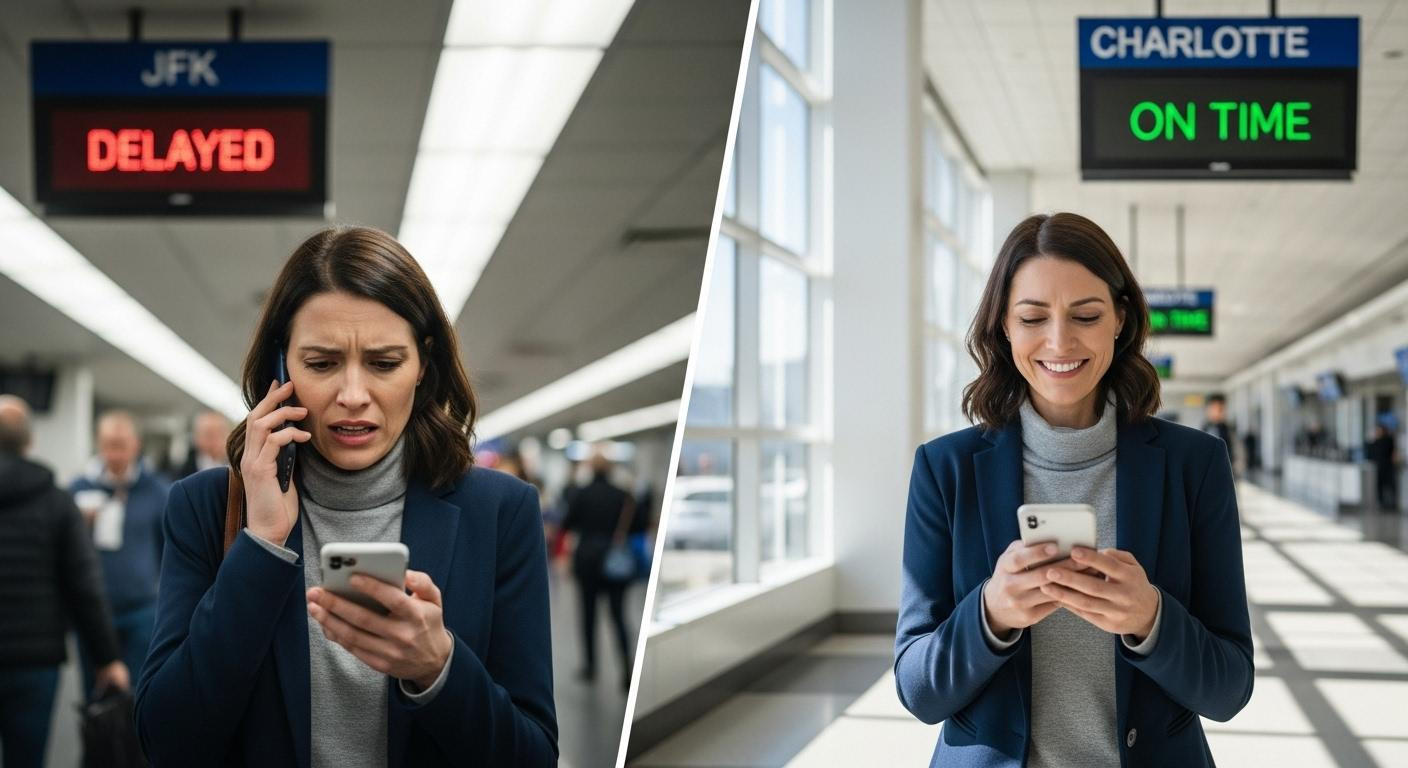The departure board at JFK flickers red: “DELAYED – WEATHER.” Around gate B12, travelers clutch phones, searching for answers. You open FlightAware, check the nor’easter’s 48-hour track, and spot something others miss: Charlotte has clear skies. Within minutes, you’re rebooked through the South while passengers around you discover their October 12th flights won’t leave until Tuesday. This isn’t luck. It’s understanding how coastal storms paralyze Northeast aviation while southern hubs stay operational.
Why nor’easters cripple Northeast airports while southern hubs remain open
The October 2025 nor’easter demonstrated this pattern perfectly. JFK passengers faced 132-minute average delays. LaGuardia hit 106 minutes. Boston Logan reached 86 minutes. Newark managed 80 minutes.
The meteorological setup creates this disruption: counterclockwise winds, coastal flooding, and visibility dropping below landing minimums. More than 500 flights were canceled, nearly 16,000 delayed across the Northeast corridor. The storm’s 500-mile radius affects everything from Virginia to Maine.
Meanwhile, Charlotte, Atlanta, and Dallas operated normally. Airlines know this pattern. They preemptively cancel Northeast flights 24 hours before storms hit. This creates your opportunity: understanding your rebooking rights before chaos begins.
The 5 real-time strategies that separate informed travelers from stranded passengers
Track storm development 24 hours before airline announcements
NOAA’s National Hurricane Center provides coastal storm tracking 5-7 days out. Accurate flight disruption predictions emerge 48-72 hours before impact. FlightAware’s real-time delay maps show developing problems at individual airports.
Airlines issue travel waivers 24-36 hours ahead of nor’easters. This window lets you rebook proactively while seats remain available on alternative flights.
Reroute through southern hubs that bypass the storm entirely
Charlotte maintains 95% on-time performance during Northeast nor’easters. Atlanta and Dallas similarly avoid disruption. These hubs add 2-3 hours to your journey but eliminate 12-24 hour delays.
Manually search airline websites for southern routing options. Customer service agents often don’t suggest these alternatives initially. Alternative transportation thinking transforms weather delays into manageable inconveniences.
Insider airline operations knowledge that changes everything
Weather waiver policies activate before storms arrive
Major carriers waive change fees 12-24 hours before nor’easters strike. Delta, United, American, and JetBlue all maintain weather advisory systems. Their Twitter feeds announce waivers before customer service phone systems update.
Each airline’s mobile app allows self-service rebooking during weather events. This bypasses 60-90 minute hold times when disruptions begin.
The proactive rebooking strategy that beats gate agent lines
Book backup flights 18-24 hours before your original departure. Keep both reservations until the last moment. Airlines typically allow this during weather waiver periods.
Target flights departing 6-12 hours before your original time. Earlier departures often escape the storm’s peak impact window. Strategic timing becomes your competitive advantage.
The technology advantage that puts you ahead of 80% of travelers
FlightRadar24 shows real-time aircraft positioning during storms. You’ll see planes diverting or holding patterns before departure boards update. ExpertFlyer reveals award seat availability during irregular operations.
Set up multi-layered alerts across airline apps. Push notifications for gate changes, equipment swaps, and crew delays arrive before airport announcements. Aviation communities on Reddit and Twitter share operational intelligence during major weather events.
The October 2025 nor’easter lasted until Tuesday morning, October 14th. Travelers with proper monitoring tools rebooked Sunday afternoon. October weather patterns require this level of preparation.
Your questions about nor’easter flight disruptions answered
How far in advance can I predict nor’easter flight cancellations?
Meteorologists identify coastal storm potential 5-7 days out. Accurate disruption predictions emerge 48-72 hours before impact. Airlines issue travel waivers 24-36 hours in advance, creating your optimal rebooking window before seat availability disappears.
Will travel insurance cover nor’easter delays and cancellations?
Standard travel insurance excludes “known weather events.” Once meteorologists issue coastal storm warnings, most policies won’t cover cancellations. Cancel For Any Reason (CFAR) policies purchased before storm forecasts cover 50-75% of non-refundable costs.
Which Northeast airports recover fastest after nor’easters pass?
Newark typically resumes operations 4-6 hours faster than LaGuardia due to superior drainage infrastructure and longer runways. JFK’s international focus means delayed inbound aircraft create 12-24 hour recovery lag. Boston Logan’s coastal position extends disruption despite strong deicing capabilities.
The nor’easter tracking map glows red across the Northeast corridor. You’re already airborne from Charlotte, arriving just 3 hours later than planned. Below, LaGuardia sits under gray clouds, departure boards filled with cancellations. You learned the patterns airlines follow, turned weather chaos into manageable delay, and proved storms don’t control travelers who think ahead.
